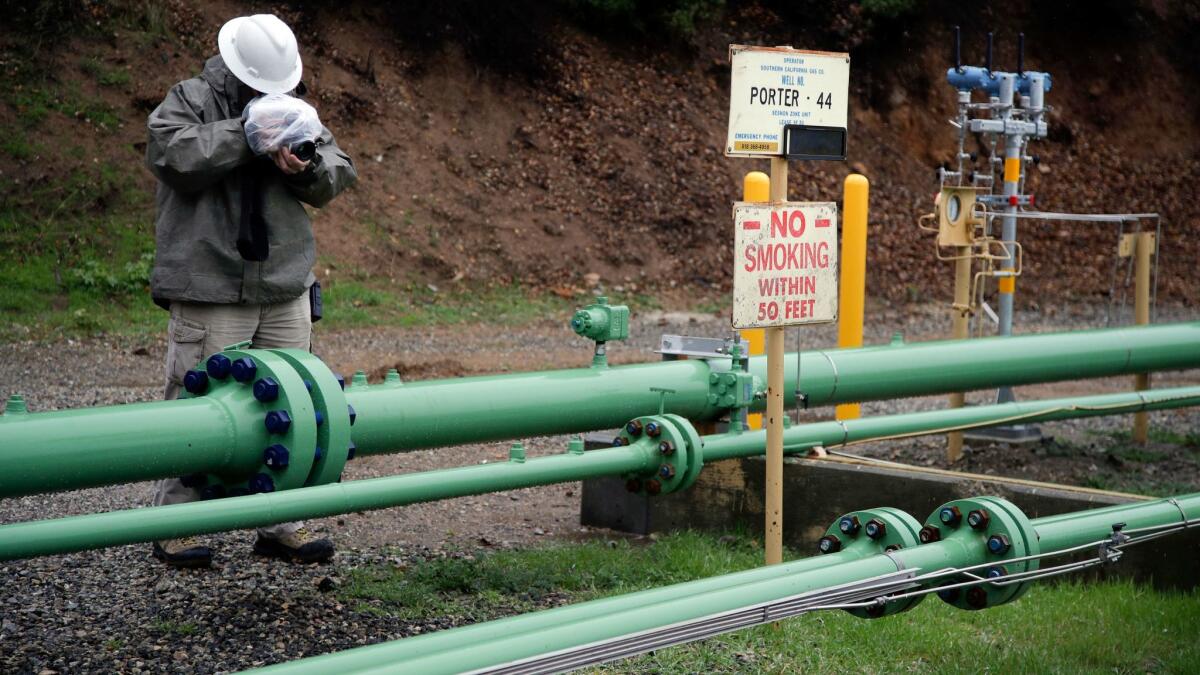Editorial: A natural gas crisis has put California at an energy crossroads

For a few days earlier this winter, it looked like Los Angeles County might run out of natural gas. Even though the country is swimming in natural gas reserves, half the gas pipelines serving the county were shut down (one has since reopened). Meanwhile, the Aliso Canyon storage facility near Porter Ranch has been operating at reduced capacity ever since the massive methane leak there two years ago. The county was one cold snap away from service interruptions.
At least, that was the worst-case scenario the California Public Utilities Commission painted as it sought to impose a moratorium on new gas hookups to commercial and industrial customers until the end of March. Southern California Gas Co. officials said the moratorium would do virtually nothing to ensure there was enough gas for a cold winter, and business groups howled their objections to this unprecedented step (no one can remember a time when natural gas supplies were in such a perilous state that so drastic an action was even suggested). As many as 700 new businesses would have been forced to wait until spring to open their doors, leaving thousands of people out of work for nearly three months. It would have been an economic blow to the region for relatively little gain, local economists said.
What are state and local elected leaders doing to prepare? Not much.
So why all the drama? The moratorium proposal was a showdown of sorts between regulators who want local governments to take steps to curtail gas demand, local officials who want Aliso Canyon shut down for good, and SoCal Gas, which wants restrictions lifted at Aliso Canyon so it can continue selling natural gas to all its current and new customers. Though it certainly got attention, it was wrong for regulators to threaten to punish a small group of businesses for the sins of others. There are protocols for cutting off gas service in emergencies crafted to avoid such punitive action.
But it is also wrong for elected officials to sit around waiting for the next local gas crisis. There will be one.
Fortunately, a warmer-than-expected winter put the moratorium on hold before anyone could feel its impact. But the issue hasn’t gone away. The PUC will consider the moratorium on gas hookups again next month. And then there’s always next year. Or the year after that. And what are state and local elected leaders doing to prepare? Not much.
The Aliso Canyon blowout was the largest methane leak in U.S. history. It should have been a catalyst for a state already moving away from fossil-fueled energy to adopt new policies inducing consumers to shift from gas to electricity generated by renewable resources. The lack of action is what prompted the PUC’s threat in the first place. SoCal Gas had been warning for months that it couldn’t promise there would be enough natural gas on hand to get through the winter unless restrictions on Aliso Canyon were lifted. Gas isn’t like electricity; it moves slowly and requires significant supplies in proximity to serve customers.
In a Dec. 4 letter to County Supervisor Kathryn Barger, who represents the communities affected by the Aliso Canyon leak, PUC President Michael Picker and California Energy Commission Chairman Robert Weisenmiller urged the county to adopt a temporary moratorium on new gas connections, noting that the county had made its wish clear for the Aliso Canyon facility to be shuttered. “However,” they added, “on the same note, the Los Angeles County has also failed to step up on behalf of its constituents and provide any alternative that would ensure they could still heat their homes in the winter and conduct other necessary household functions.”
Even if Aliso Canyon eventually gets restrictions lifted, there are still risks associated with natural gas facilities near residential neighborhoods, as a recent report by the nonpartisan California Council on Science and Technology points out. The risks can be managed with investment, but “the state needs to weigh the risks associated with underground gas storage against the benefits” and also “compare potential alternatives to underground gas storage in a similar risk-benefit framework,” the report’s authors contend.
Natural gas is also a fossil fuel, which is why environmentalists support a short-term hookup moratorium as a wake-up call to California’s elected officials. If state lawmakers are serious about moving away from fossil fuels such as natural gas, and if local officials want a future without the risks that come with nearby gas storage wells, they can’t wait until the next crisis. They must take action now.
Follow the Opinion section on Twitter @latimesopinion and Facebook
More to Read
A cure for the common opinion
Get thought-provoking perspectives with our weekly newsletter.
You may occasionally receive promotional content from the Los Angeles Times.










